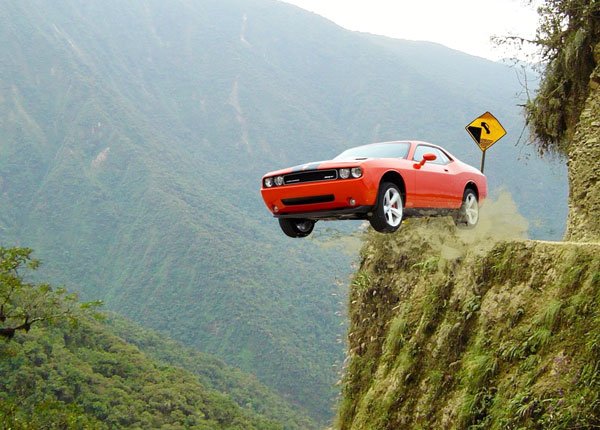
Traction in Hazardous Driving Environments: Preventing Traction Loss
Updated Dec. 14, 2020Many hazardous roadway situations can lead to loss of traction in your vehicle’s tires. The word “traction” describes a tire’s ability to grip the surface of the road. Without traction, your wheels cannot roll and will simply slide across the surface of the road instead. Maintaining traction is necessary to be able to stop, start and steer your vehicle.
In this module, we introduce the idea of traction and how it is affected by adverse roadway conditions. Later, our section on natural forces and the science of driving will explore traction in more detail. For now, all you need to know is that traction is only possible when your tires can push against the road without slipping. This can be a problem when the road surface is slick due to water, ice, snow, mud, wet leaves, chemicals or another slippery substance.
What affects traction?
There is no single factor that determines how well your vehicle can grip the surface of the road. Traction (or lack thereof) is influenced by a whole host of different issues, some of which you can control. Unless you know the area you are driving in well enough to avoid a particularly hazardous stretch of roadway (perhaps, one that is being re-surfaced or is especially dangerous in bad weather), you cannot control environmental factors that affect traction. However, you can manage the way you drive and maintain your vehicle, in order to maximize traction when you encounter hazardous conditions.
Generally, rough or textured surfaces create good traction, while smoother surfaces lead to poor traction. These are the main factors that affect traction while driving:
- 1

The material the road surface is made from.
Most well-maintained roadways are surfaced with materials that are designed to improve traction, such as asphalt. Very rural or poorly maintained roads are often broken, uneven or paved with loose material like gravel and offer less traction as a result. - 2

The condition of the road.
Traction between your car’s tires and the surface of the road will be significantly reduced when the roadway is smooth, wet or slick due to environmental conditions. Rain, snow & ice, mud, wet leaves and chemical residue from vehicles are some of the worst traction-reducing substances. Studies have shown that stopping on wet asphalt takes up to 25 percent longer than stopping in dry conditions. - 3

The condition of your tires.
Like road surfaces, vehicle tires are designed to maximize traction. Badly worn or poorly inflated tires will lessen your grip on the surface of the road. Worn tires tend to have lower tread and a smoother surface than newer tires, making it easier for them to slip across the road surface. Overinflated tires also create a smoother, traction-reducing surface as the excess air they contain bloats them outward. Underinflated tires technically increase traction but are equally dangerous, as they provide less stability for your vehicle during turns. - 4

The weight of your vehicle.
The weight of your vehicle affects how much traction your tires have with the road. Heavier vehicles generally have better traction than lighter vehicles, as traction increases the more weight there is pushing the tires against the road’s surface. Keep in mind that a vehicle’s kinetic energy (how much energy it has when it moves) and the force required to start it or stop it also increases with weight. This means a heavier vehicle will need greater traction to pull off or slow down than a lighter vehicle. - 5

The balance of your vehicle.
Vehicle balance refers to the distribution of a car’s total weight across its four wheels. An even spread of weight is ideal when it comes to maintaining traction and keeping control of your car. Various factors can cause your vehicle to become imbalanced, with more weight pushing into the front, rear or side tires. In this situation, the tires bearing less weight will have poorer traction. Acceleration, deceleration, turning and heavy loads in your trunk can all adversely affect your vehicle’s balance.
The dangers of traction loss
Losing traction in your vehicle’s front tires can lead to a dangerous situation known as understeering. When understeering occurs, the vehicle will be unresponsive to steering and may continue to travel straight forwards while you attempt to turn to the left or right. This often happens when taking a bend in the road on a slick road surface or at too high a speed. Instead of following the curve of the road, the vehicle will continue on a straight path directly toward the roadside.
Rear tire traction loss can result in oversteering. When the rear tires have little to no grip on the road’s surface, steering your car will have exaggerated results. Loss of rear wheel traction often occurs when braking while driving through a curved road. In this instance, the drop in speed would shift weight into the front tires, lessening the rear tire grip and causing your rear end to swing out in the opposite direction of the turn.
Traction loss when it rains
Water on the roadway due to rain or flooding will decrease your vehicle’s grip on the surface of the road. Pooled water on the roadway is an obvious danger, though many drivers fail to realize how hazardous even a little moisture on the road can be. As far as traction loss is concerned, one of the most hazardous environments is a lightly wet roadway during the first 10 to 15 minutes after it has begun to rain – especially if it has not rained for a long time prior to this.
When a thin film of rain collects on a relatively well-traveled road after a dry spell, it will lift dirt, oil and other chemical residue left behind by vehicles out of the road surface. This combination of water and slick chemicals then sits on the surface of the asphalt, dramatically decreasing traction while being practically invisible to motorists. If it continues to rain moderately beyond this point, the chemicals will eventually be washed away, leaving traction slightly improved.
Hydroplaning is another dangerous effect caused by your car wheels losing all traction with tarmac and beginning to slide across the surface of water on the road. Reducing speed is the only effective means of preventing hydroplaning.
Dealing with traction loss
Safe, defensive drivers always focus on prevention rather than cure when avoiding accidents and crashes. There are tactics you can employ to correct traction loss if it occurs unexpectedly and causes your vehicle to skid, though your focus should be on driving cautiously and maintaining your vehicle, to stop traction loss from happening in the first place. To prevent traction loss:
- Always adjust your speed to suit current roadway conditions.
- Make sure your tires have deep enough tread and get them replaced at appropriate intervals.
- Keep your tires topped up with air, to the manufacturer’s specified pressure.
- Get your vehicle serviced regularly and address any issues with suspension, to maintain optimal vehicle balance.
The module “Correcting Traction Loss” in a later section of this course provides an in-depth lesson in dealing with traction loss in different driving situations. This is important safety information, so make sure you study it thoroughly. For now, we’ll get you started with a brief summary of how to correct traction loss when it occurs.
If you lose traction in your front tires:
- 1

Look and gently steer in the direction you want the car to go.
Do not steer sharply, as this can worsen a skid. - 2

Ease your foot off the accelerator to re-balance your car.
Pumping the brake pedal sharply can throw weight back into the front wheels and help them regain traction. - 3

Continue steering gently as your front tires begin to grip the road.
If you lose traction in your rear tires:
- 1

Focus your gaze in the direction you are trying to go.
Do not look toward the roadside. - 2

Ease your foot off the brake or gas to help re-balance your car’s weight.
As your wheels roll, they should start to regain traction. - 3

Keep steering gently in the direction you wish to travel.
Be prepared to re-align your vehicle by steering in the opposite direction as the oversteer is corrected. - 4

As you re-align your car with the road, accelerate gently to shift weight back into the rear wheels.
Traction control systems (TCS)
Many people erroneously believe that in-built traction control systems (TCS) can improve grip in the same way that tire chains would, stopping their vehicles from getting stuck in deep snow or ice. This is not the way that electronic traction control operates. However, they do improve the way your vehicle responds to poor traction environments.
Most modern vehicles are built with electronic traction control systems to minimize traction loss on slippery road surfaces. Some of these systems electronically manage the amount of acceleration power going to the drive wheels, so that the driver does not have to worry about pressing the gas pedal too forcefully and causing the wheels to spin.
In most vehicles with TCS, an electronic sensor detects how fast the drive wheels are rotating. A wheel that has lost traction will slip against the surface of the road and spin faster than the other wheels. When traction control senses this, it will automatically press and release the brake on the faster wheel, to slow it down until it regains traction.




